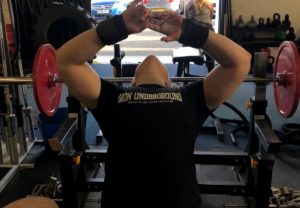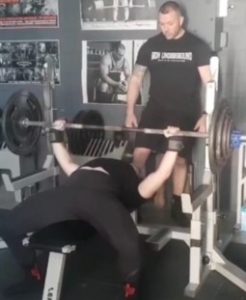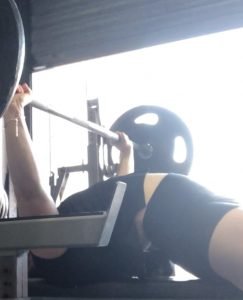Hannah Altman – How Does The Bench Press Work?
Let’s talk bench press – arch and bench contact.
For women, the bench-press is arguably one of the hardest lifts to progress. In this next series of articles, coming out every two weeks for Powerlifting4women, we will be discussing how to break through the bench and avoid injury.
A major point to consider with bench-press is that it is an extraordinarily technical lift and there is not a lot of room for technical breakdown if you want to get three white lights in competition.
The first thing to keep in mind with regards to bench-press is the set-up.
You need to set up to ensure your hands are in the right position for your body type and for how you’ll need to build your bench strength. This is because bench-strength is built in the accessory work that you do (December article).
Once you grip the bar you need to ensure that your feet are set so you have leg drive. You must have a decent arch such that your bum is in contact with the bench. You need to ensure that your arms are fully extended and that you don’t lose your arch when you unrack the bar because the bigger the arch the less the bar needs to travel.
Not losing that arch can come down to your breathing technique as one of many factors. Once you start the bench you lower the bar through the eccentric (downward phase) movement, then you need to be able to hold that stopping position at the bottom long enough to get a press command from the referee.
The concentric (upward phase) part is where things often go wrong in the bench press. You need to ensure your feet don’t move, your bum stays on the bench, the bar only moves in one direction (meaning that if you get stuck and the weight pushes you down you are finished). Also, you need to try and avoid hitting the rack because that can throw off your bar path and you won’t be able to lock it out. Oh, and don’t beat your rack command.
So, to summarize, there are heaps of components that go into doing a proper bench-press and if your technique is off you are likely to slip up and will end up getting a red light.
One of the biggest mistakes that lifters make is that they don’t train variation in their lifts. Every lifter has a sticking point and different variations of the bench-press can target those weak points so that you don’t fail your bench-press at the same point in the lift.
In this article, I’m going to focus on what, in my opinion, is the most important part of the female bench-press and how to avoid one of the biggest red light makers in bench. This refers to an Instragram post from the 23rd of August 2019 on HannahAltman ES.
The reason why we arch our back is to minimize the distance that the bar has to travel (shorter bar path). Though the one little down side of the arch is that the bigger the arch is higher the risk of lifting your bum of the bench.
This being said, there is a lot of false information out there claiming that arching one’s back for females will cause lifetime back injury.
What many don’t take into consideration is the fact that lumber and thoracic vertebrae and inter-vertebral discs are actually safest in a lordodic position, which is the fancy term for being arched. The main reason for this is that discs tend to herniate posteriorly due to the presence of an incredibly robust anterior longitudinal ligament in front of the spine.
Even if the disc somehow manages to herniate anteriorly, the resultant herniation would likely be asymptomatic as the spinal nerves are behind the inter-vertebral discs, not in front of them. Arching the lower and mid back does not push the limit-range of motion of the cervical spine in the neck, so there is less concern of the probability of injuring the neck with arched benching.
If your form is correct, arched benching (with a retraction of the scapulae) allows a greater use of the lower fibres of the chest muscles. Not only is this pushing angle likely safer for the glenohumeral joint of the shoulder, it’s also conducive to the great use of the larger mass of lower fibres (vs. upper fibres) of the pectoralis. This creates a more forceful lift without sacrificing as much safety as a flat pressing position might (August 24th 2019).
This being said, an increasingly common que used by coaches is to bench with one’s legs. The issue then becomes that when we do this we lift our bum off the bench, causing one to get three red lights. We end up lifting our bum, using this approach because when we drive through our legs we initiate the force towards the ceiling, which pulls our bums up.
However, if we focus on driving our shoulder into the bench, the force goes into driving the bar back up which is more likely to end in more bar speed and no red lights.
There is heap more that goes into the bench-press. Our next article will be on how to use the bench to generate more force and to minimise shoulder injuries.
About the Author:
Hannah Altman is a qualified exercise scientist BHS| BCOM | MPHIL and Strength Coach Fitrec, a Pilates instructor and Nutrition Coach PN1 Elemental L2, focusing on injury prevention for strength athletes. She is currently studying for her doctorate at Queensland University of Technology.
She holds multiple junior bench-press records, the current one being 95kg and has a top bench-press of 103kg at 69kg body weight. She is ranked in the top 20 in Australia based on Wilks in all three lifts and in Bench-Press.
She is currently coaches out of Iron Underground in Albion, Brisbane and online.
To book a complementary session; to get a 10% discount for rehab, prehab or just performance and to increase your bench, choose from the options below. Contact Hannah on 0452285271.



